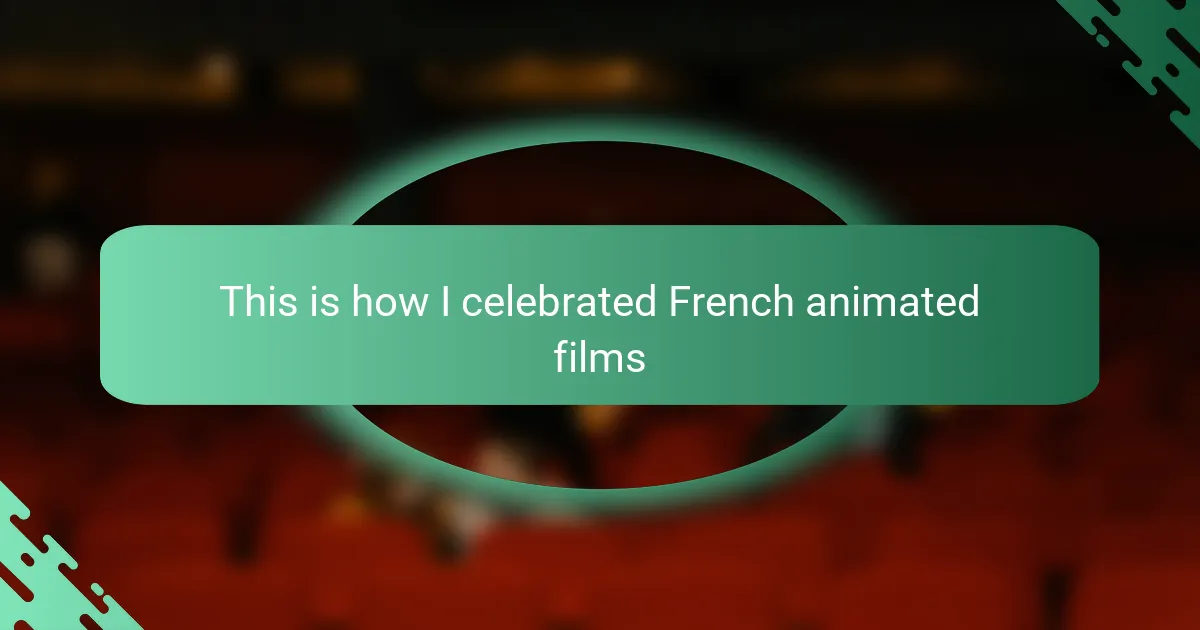Key takeaways
- French animated films blend traditional artistry with modern techniques, offering unique storytelling that resonates with all ages.
- These films often tackle profound social themes, prompting viewers to reflect on their experiences while evoking a range of emotions.
- Key films such as “The Triplets of Belleville” and “Persepolis” highlight cultural narratives and personal resilience through their distinct animation styles.
- Enhancing the viewing experience can be achieved by creating a cozy atmosphere, engaging in discussions, and exploring soundtracks related to the films.
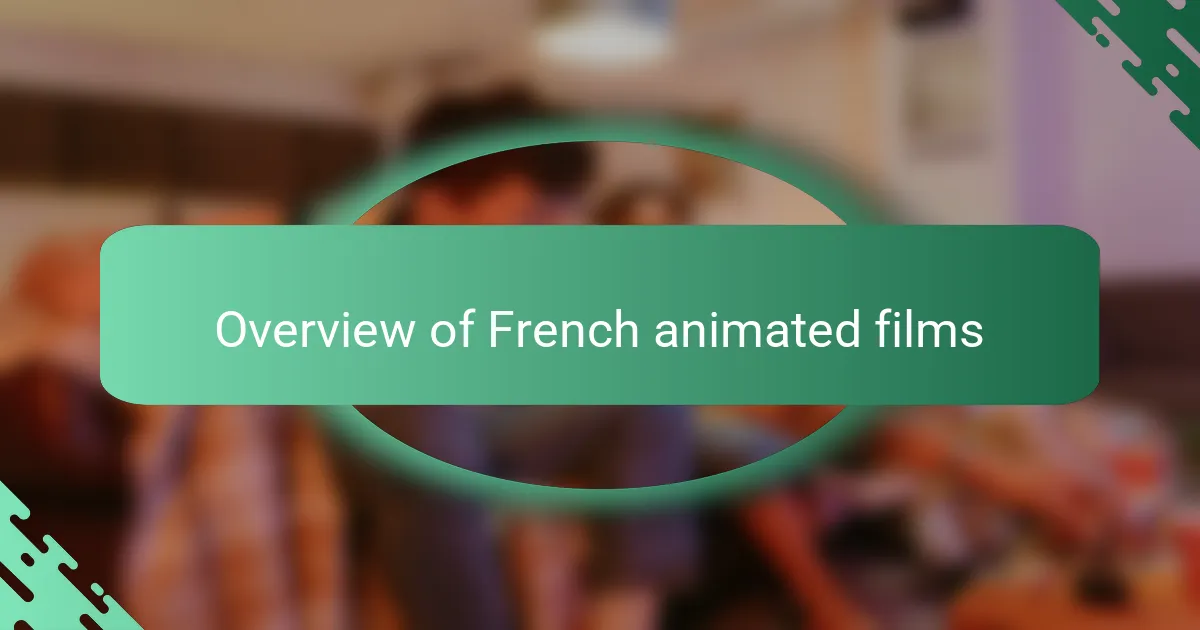
Overview of French animated films
French animated films have a vibrant history that reflects the culture’s unique artistry. When I think about these films, I remember the feeling of awe watching classics like “The Triplets of Belleville” and “Persepolis.” They not only entertain but also convey deep emotions and social messages, capturing the essence of human experience in beautifully animated frames.
It’s fascinating how French animation has evolved over the years, blending traditional hand-drawn techniques with modern digital artistry. I often find myself drawn to the distinct style and storytelling prowess that sets these films apart on the global stage. They have a way of resonating with viewers of all ages, making them timeless.
Here’s a brief comparison of notable French animated films:
| Film | Release Year | Director | Style |
|---|---|---|---|
| The Triplets of Belleville | 2003 | Sylvain Chomet | Hand-drawn, surreal |
| Persepolis | 2007 | Marjane Satrapi, Vincent Paronnaud | Black and white, autobiographical |
| Ernest & Celestine | 2012 | Stéphane Aubier, Vincent Patar | Watercolor, whimsical |
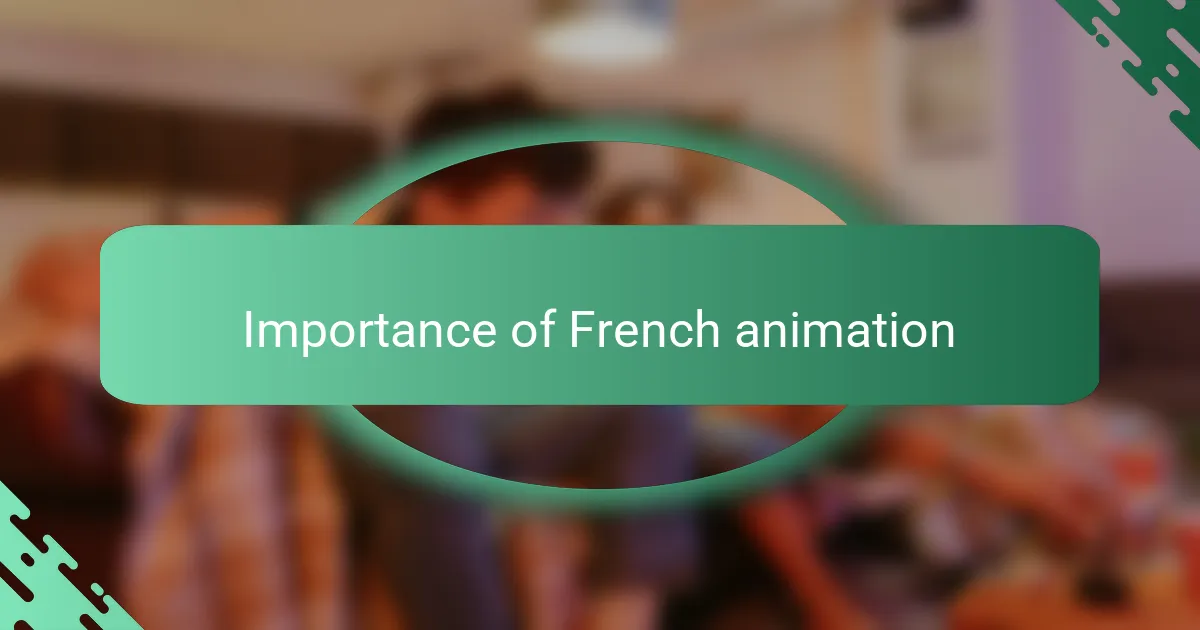
Importance of French animation
French animation holds a unique spot in the film industry, blending artistry with compelling storytelling. I recall watching “The Triplets of Belleville” as a child; its quirky style and touching narrative left a lasting impression on me. This authenticity reflects the cultural richness of France and resonates with audiences worldwide.
The significance of French animation extends beyond entertainment; it often tackles profound themes with a creative flair. Many films mirror societal issues, inviting viewers to reflect on their own experiences. I find it fascinating how these animated works can evoke both laughter and deep introspection.
- Combines artistic expression with rich storytelling.
- Frequently addresses social and cultural themes.
- Evokes a wide range of emotional responses, from joy to contemplation.
- Encourages creativity and innovation within the animation industry.
- Appeals to audiences of all ages, fostering a love for animation.
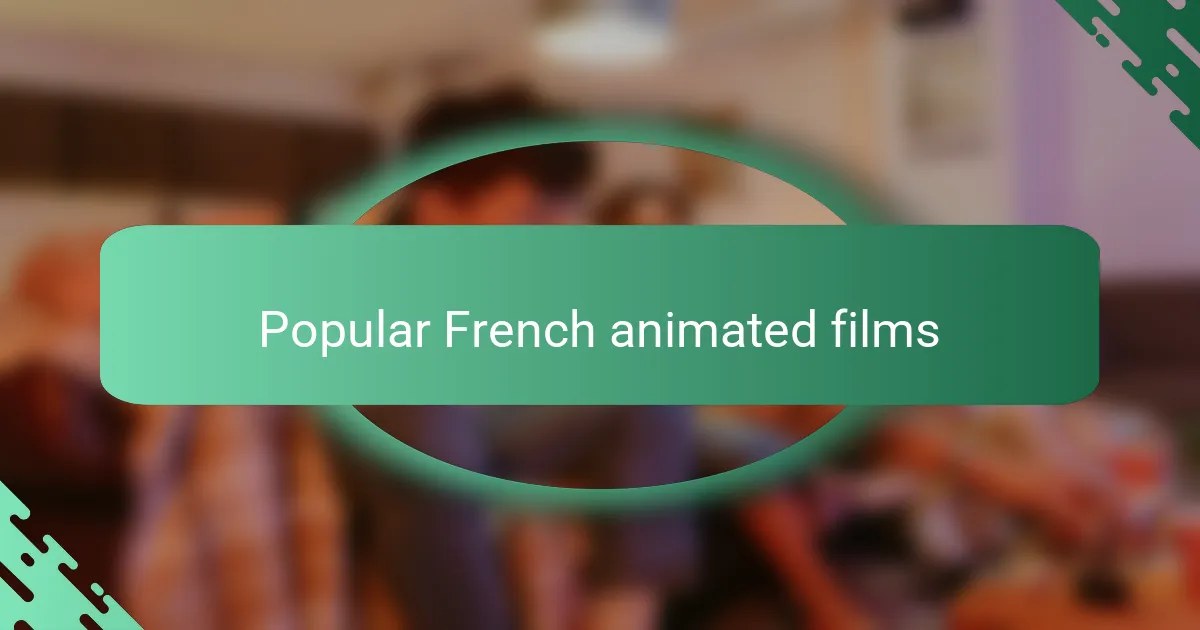
Popular French animated films
French animated films have a unique charm that often evokes a sense of nostalgia and wonder. I vividly remember watching “Le Petit Prince,” a stunning adaptation of Antoine de Saint-Exupéry’s beloved novella. Its whimsical visuals and poignant storytelling reminded me of the importance of imagination and childhood innocence, something that resonated deeply with me during my own formative years.
Another standout is “The Triplets of Belleville,” which uses minimal dialogue yet tells a rich story through its quirky characters and vibrant animation style. The film’s humor and creativity truly showcase the ingenuity of French animation, sparking my appreciation for the art form. It’s these films that stick with you, often reminding you how animation can transcend language and cultural barriers.
Here are some popular French animated films you might love:
- Le Petit Prince (The Little Prince)
- The Triplets of Belleville (Les Triplettes de Belleville)
- Ernest & Celestine (Ernest et Célestine)
- A Cat in Paris (Un chat à Paris)
- The Secret of Kells (Le Secret de Kells)

Criteria for reviewing animated films
When reviewing animated films, I focus on a few key criteria. First, I pay close attention to the storytelling. A captivating narrative can elevate an animated film, bringing characters to life in ways that resonate with audiences of all ages. For instance, I remember the first time I watched “The Triplets of Belleville.” The unique storytelling and minimal dialogue made the film’s emotional depth shine.
Next, the animation style plays a significant role. Different techniques evoke different feelings. Personally, I find hand-drawn animation adds a charming quality that often feels more personal. I felt a nostalgic connection with “Persepolis,” which utilized this style beautifully while tackling profound themes.
Lastly, the music and sound design can greatly enhance the viewing experience. Look at how the soundtrack influences mood in films like “The Red Turtle.” The sounds complement the visuals perfectly, creating an immersive atmosphere that lingers long after the credits roll.
| Criteria | Explanation |
|---|---|
| Storytelling | Quality of narrative and character development |
| Animation Style | Technique used and emotional impact |
| Music and Sound Design | Integration of audio elements with visuals |
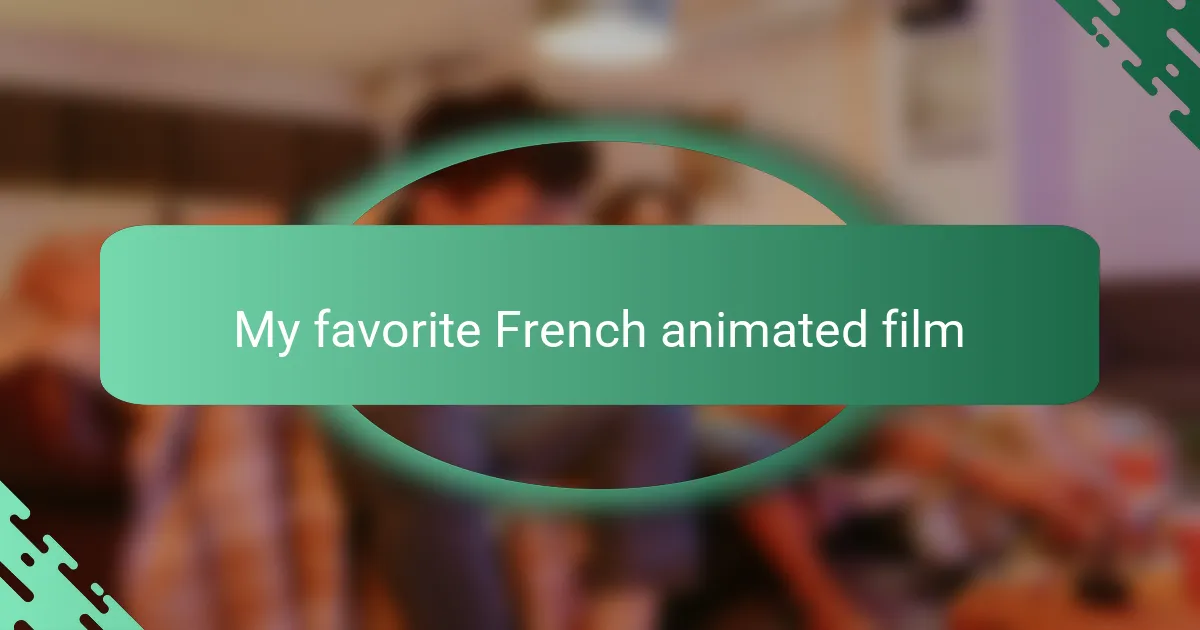
My favorite French animated film
One of my favorite French animated films has to be “The Triplets of Belleville.” The unique blend of hand-drawn animation and quirky characters makes it an unforgettable experience. I remember the first time I watched it; I was captivated by the enchanting world that truly embodies the charm of French culture.
The film beautifully showcases the bond of family and the raw determination of a grandmother. I’ve often drawn inspiration from Madame Souza’s unwavering spirit, a reminder that love knows no bounds. It’s a film that resonates emotionally and artistically, leaving a lasting impression long after the credits roll.
Here’s a quick comparison table to illustrate my thoughts on “The Triplets of Belleville” compared to another popular French animated film, “Persepolis.”
| Film | Main Theme |
|---|---|
| The Triplets of Belleville | Family and determination |
| Persepolis | Identity and culture |
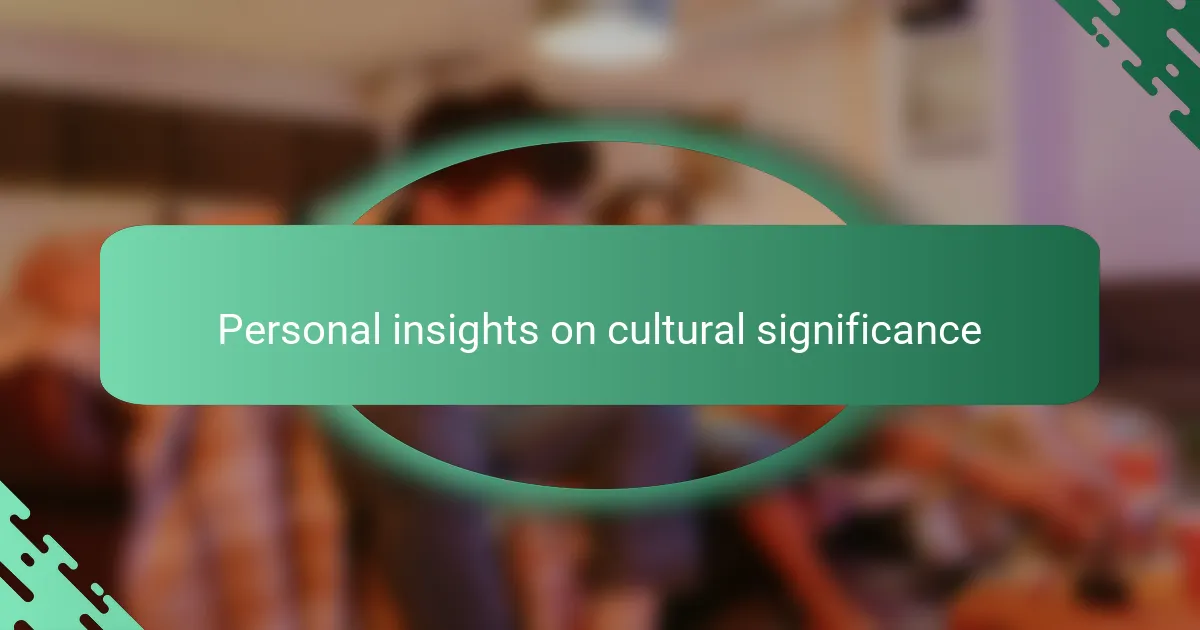
Personal insights on cultural significance
When I think about the cultural significance of French animated films, I’m often reminded of my childhood experiences. The whimsical stories and vibrant visuals allowed me to escape into different worlds, and I still feel that same enchantment when I watch films like “Persepolis” or “The Triplets of Belleville.” These films reflect not just entertainment but also deep cultural narratives that resonate with both children and adults alike.
What I find truly compelling is how these animated films tackle complex themes within beautiful artistry, leaving a lasting impact on audiences. They encourage viewers to question societal norms and connect with various aspects of the human experience. It’s fascinating how a medium often perceived as children’s entertainment carries such depth and significance.
- French animated films often intertwine humor with poignant social commentary.
- They celebrate French culture and history, providing a window into its rich narratives.
- The unique artistic styles of these films draw inspiration from traditional French art, enriching the viewing experience.
- Personal stories, like those shared in “Persepolis,” highlight individual resilience and the fight against adversity.
- Many animated films invite intergenerational discussions, bridging gaps between old and young.

Recommendations for viewing experiences
When it comes to enhancing your viewing experience of French animated films, consider creating a cozy atmosphere. I remember my first time diving into “Ernest & Celestine” on a rainy afternoon. The warmth of my blanket and a steaming cup of tea transformed the experience into something magical. Lighting dimmed, distractions minimized; it truly made the film’s whimsy come alive.
If you’re watching with family or friends, engage in discussions before and after. I cherish the conversations that spark over films like “The Triplets of Belleville,” where we dissect the characters’ journeys and moral lessons. These dialogues not only enrich the viewing experience but also deepen connections with others, turning a simple film night into a meaningful bonding opportunity.
Lastly, don’t shy away from exploring the accompanying soundtracks. I often play the score from “Persepolis” while working; those melodies evoke nostalgia and inspiration. The immersive power of music in animated films cannot be understated—so why not let it transport you further into the soul of the story you’re watching?
